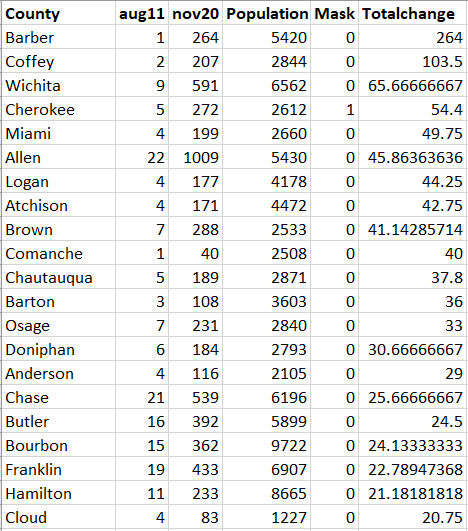I want to elaborate on why ignoring urban/rural in Kansas mask study is a big deal bordering scientific malpractice:
Smaller counties are more likely to be no-mask. They are also much more sensitive to case changes in % terms.
The authors use % change as their criterion. (1/7) https://twitter.com/covidtweets/status/1330734764513497088">https://twitter.com/covidtwee...
Smaller counties are more likely to be no-mask. They are also much more sensitive to case changes in % terms.
The authors use % change as their criterion. (1/7) https://twitter.com/covidtweets/status/1330734764513497088">https://twitter.com/covidtwee...
The authors say "... counties were compared to themselves over time, allowing for the control of constant county-related characteristics (e.g., urbanicity or rurality) that might otherwise confound a comparison between mandated and nonmandated counties." This is BS... (2/7)
When you use percentages as the criterion, smaller counties will see bigger jumps after a small absolute increase in cases. This is basic math. Yet all the Ph.D.s who have written this seem to be ignorant of this fact. (3/7)
Look at the counties below, all no-mandate except for Cherokee. Avg. population is 4,383. Average case increase between Aug11-Nov20 is 5,000%.
You read that right, five-thousand-percent!
Comanche County saw an increase of 4,000% - their cases increased from 1 to 40... (4/7)
You read that right, five-thousand-percent!
Comanche County saw an increase of 4,000% - their cases increased from 1 to 40... (4/7)
The study uses cases within a time period instead of cumulative, which alleviates this to some extent, but still, a small county is more likely to have 2 cases one week and 10 cases the next (500% increase). (5/7)
That& #39;s why I excluded these small counties in my analysis below, along with major urban counties. That& #39;s the only way to minimize the bias caused by urban vs. rural confound.
Yet, the CDC publishes this as a scientific study.... (6/7) https://twitter.com/covidtweets/status/1330734767554359296?s=20">https://twitter.com/covidtwee...
Yet, the CDC publishes this as a scientific study.... (6/7) https://twitter.com/covidtweets/status/1330734767554359296?s=20">https://twitter.com/covidtwee...
I would be ashamed to put my name on this as a scientific publication. Yet here we are. It is published by the CDC, none the less...
I guess this is the norm given the standards of scientific inquiry in 2020... (7/7)
I guess this is the norm given the standards of scientific inquiry in 2020... (7/7)

 Read on Twitter
Read on Twitter


